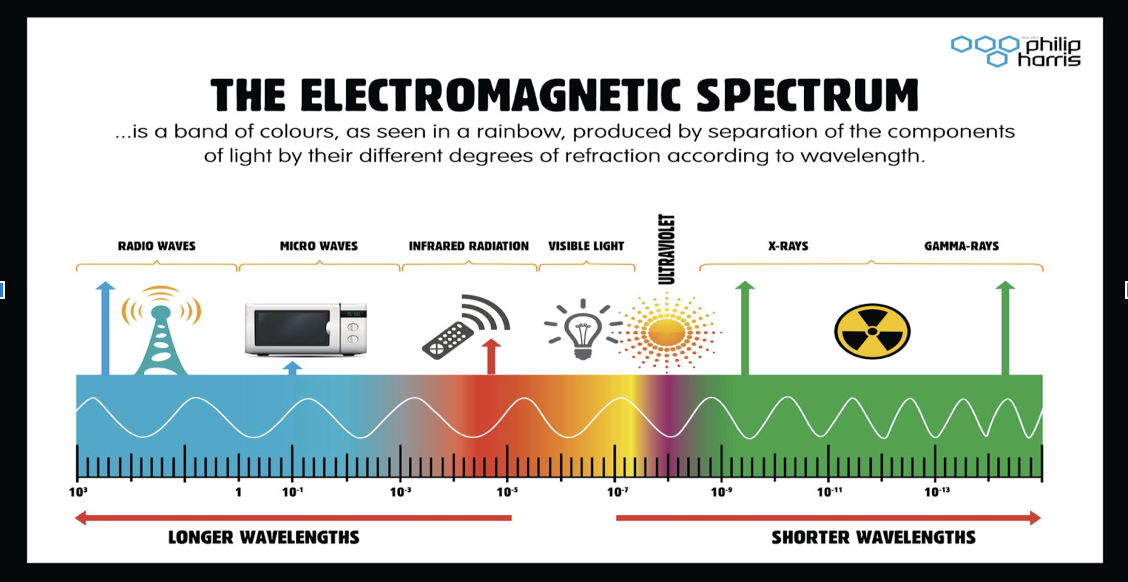Introduction:
In today’s technologically advanced world, we are constantly surrounded by electromagnetic fields (EMFs) emanating from various electronic devices and communication systems. EMF’s are literally and figuratively omnipotent. While these devices have undoubtedly improved our lives, concerns about potential health effects from EMF radiation have emerged. In this comprehensive guide, we will delve into the nature of EMF radiation, explore its various sources, and discuss its potential effects on our cells and specific organ systems. Additionally, we will present practical ways to protect ourselves against EMF radiation.
What is EMF Radiation?
Electromagnetic fields (EMFs) encompass waves of electric and magnetic energy that propagate through space. These fields are generated by both natural and human-made sources. Natural sources include the Earth’s magnetic field and cosmic radiation, while human-made sources comprise everyday electronic devices like cell phones, laptops, Wi-Fi routers, power lines, and more. Within the EMF radiation spectrum, we will focus on two significant components: extremely low-frequency (ELF) radiation and radiofrequency (RF) radiation.

It was once thought that neither of these were harmful to health because they don’t produce measurable thermal (temperature) changes in objects or people. We now know that heating is not the issue, and that these guidelines are missing a crucial component of this field of study. More on this in the coming sections.
Testing Standards:
One of the significant challenges in evaluating the health effects of EMF radiation lies in outdated testing standards. The Federal Communications Commission (FCC) sets the standards for EMF radiation exposure, relying on outdated testing methodologies (from the 1990’s). These standards primarily focus on assessing the thermal effects of EMF radiation, neglecting potential non-thermal biological effects, such as DNA damage and cellular stress. In actuality, recent findings (that do not focus on thermal changes) have forced the World Health organization (WHO) to categorize EMF radiation as a group 2B human carcinogen. Recent studies have indicated the EMF radiation should in fact be considered a class 1 carcinogen.
Moreover, an analysis published in 2019 explored the association between funding and testing results. The study titled “Extremely low frequency electromagnetic fields and cancer: How source of funding affects results” investigated the potential influence of funding sources on research outcomes related to the association between extremely low frequency electromagnetic fields (ELF-EMF) and cancer. The researchers found that studies funded by industry-related sources tended to report a lower likelihood of an association between ELF-EMF exposure and cancer risk, while studies funded independently of industry interests were more likely to report a potential link.
These findings highlight the importance of considering funding sources and potential biases when interpreting research on the health effects of electromagnetic fields and underscore the need for independent and objective investigations to provide a more comprehensive understanding of the topic.
The Mannequin Test:
To determine compliance with the FCC guidelines, testing is conducted using a model based on a mannequin filled with liquid to simulate the thermal properties of human tissue. This mannequin test assesses whether a device’s EMF radiation causes a significant increase in temperature in the liquid-filled mannequin. Unfortunately, this approach overlooks the potential biological effects of non-thermal EMF radiation exposure, leaving the public inadequately protected. It is truly an inadequate way to test the biological effects of EMF radiation.
Challenges Posed by the FCC:
The FCC’s role in regulating EMF radiation has raised concerns about its objectivity and potential conflicts of interest. Critics argue that the FCC’s reliance on outdated testing standards and its focus on industry interests rather than public health may lead to incomplete assessments of EMF radiation’s potential risks. This raises questions about the FCC’s willingness to fully disclose the health effects of EMF radiation, potentially leaving the public in the dark about potential risks.
Top Sources of EMF Radiation
Understanding the primary sources of EMF radiation is crucial for managing our exposure. Common sources include:
Electronic Devices: Cell phones, smartphones, tablets, laptops, computers, and wearable devices emit RF radiation during wireless communication.
Wi-Fi Routers: Wi-Fi networks emit RF radiation to provide wireless internet connectivity.
Power Lines: High-voltage power lines and electrical wiring emit ELF radiation due to the flow of electric current.
Household Appliances: Appliances like microwaves, refrigerators, and hair dryers emit EMF radiation during regular operation.
Cell Phone Towers: Cell towers emit RF radiation to facilitate wireless communication and data transfer.
Radar and Satellite Systems: Certain industries and government applications use radar and satellite systems, which can produce EMF radiation.
Effects of EMF Radiation on Health
At the cellular and molecular level, electromagnetic fields (EMF) can interact with human biology in various ways, potentially leading to harmful effects. While the full extent of these interactions is still a subject of ongoing research and debate, several key focus areas have been identified, including the generation of reactive oxygen species (ROS), DNA damage, alterations in calcium ion homeostasis, and effects on the blood-brain barrier. Listed are some of the body systems affected by EMF radiation:
A. Cancer: One of the most debated and extensively studied areas is the potential link between EMF radiation and cancer development. Epidemiological studies have investigated the association between prolonged EMF exposure and the risk of certain cancers, particularly brain tumors (glioma and acoustic neuroma). The International Agency for Research on Cancer (IARC) has classified RF radiation as “possibly carcinogenic to humans” (Group 2B), based on evidence of an increased risk of glioma and acoustic neuromas.
B. Cardiovascular System: Some studies have explored the potential effects of EMF radiation on the cardiovascular system. Prolonged exposure to EMFs has been associated with alterations in heart rate variability and changes in blood pressure, indicating potential effects on the autonomic nervous system. Additionally, some research suggests that EMF exposure may contribute to endothelial dysfunction, which could be a risk factor for cardiovascular diseases.
C. Female Reproductive Health: There is evidence suggesting possible disruptions to reproductive function. A comprehensive review reported a negative association between EMF exposure and female fertility, indicating that prolonged exposure to EMF radiation may have implications for conception.
D. Male Reproductive Health: Several studies have explored the potential link between prolonged exposure to RF radiation and reduced male fertility. EMF radiation emitted by cell phones and other wireless devices can lead to increased oxidative stress, DNA damage, reduced sperm motility, quantity, and quality. Additionally, EMF radiation exposure may negatively impact testosterone levels, further affecting male reproductive health.
E. Central Nervous System: The central nervous system (CNS), particularly the brain, has been a major focus of EMF radiation research. Studies have investigated the effects of EMF exposure on brain function, cognitive performance, and the risk of neurological disorders. Some research has reported alterations in brain activity, changes in cognitive function, and potential implications for conditions like Alzheimer’s disease and other neurodegenerative disorders.
F. Immune System: Research on the effects of EMF radiation on the immune system is still in its early stages. Some studies have suggested that EMF exposure may lead to changes in immune cell function and the release of pro-inflammatory cytokines. These alterations could potentially impact the body’s immune response and susceptibility to certain diseases.
Protecting Ourselves from EMF Radiation:
Reducing or minimizing exposure to EMF radiation from devices is a proactive approach to potentially mitigate any associated health concerns. As awareness of potential health effects grows, individuals seek effective ways to reduce EMF radiation exposure. Here are some simple ways individuals can achieve this:
SILVERLINING’s ALPHA briefs offer a cutting-edge solution designed to protect against EMF radiation exposure. These briefs are equipped with EMF shielding fabric, which effectively blocks harmful EMF radiation away from the body, particularly in the cellphone/laptop range. Designed with both comfort and style in mind, these briefs offer a perfect fit and are suitable for everyday wear, ensuring convenience and protection throughout the day.
Avoid carrying cell phones and other wireless devices directly against your body, especially in pockets or bras. Instead, keep devices in a bag.
Reduce the time spent on cell phones, especially for lengthy phone calls or streaming. Use texting or speakerphone when feasible.
When making calls, use the speakerphone function or wired headsets, as this keeps the phone away from your head and reduces direct exposure to your brain.
Keep cell phones, laptops, and tablets away from the bedside table while sleeping. Alternatively, you can switch your phone to airplane mode and turn off your laptop’s Wi-Fi connectivity.
Minimize children’s exposure to wireless devices, as they may be more vulnerable to potential risks due to their developing bodies. Encourage more outdoor and interactive play instead.
Remember that while these steps may help reduce EMF exposure, it’s essential to strike a balance between precaution and practicality. Many of these recommendations are based on the precautionary principle, acknowledging potential risks while recognizing the need for further research to fully understand the long-term effects of EMF radiation on human health.
Conclusion:
In our technologically advanced world, electromagnetic fields (EMFs) are ubiquitous, generated by various electronic devices and communication systems. While these devices have undoubtedly improved our lives, concerns about potential health effects from EMF radiation have emerged. This comprehensive guide has explored the nature of EMF radiation, its various sources, and potential effects on our cells and specific organ systems, particularly male fertility.
At the cellular and molecular level, EMF radiation can lead to oxidative stress, DNA damage, disruptions in calcium ion homeostasis, and effects on the blood-brain barrier. Studies have indicated a link between prolonged exposure to RF radiation and reduced male fertility. EMF radiation emitted by cell phones and other wireless devices can negatively impact sperm cells, reducing motility, quantity, and quality. Additionally, exposure may lower testosterone levels, further affecting male reproductive health. However, it is important to note that this area of research is still evolving, and more studies are needed to fully understand the extent of EMF’s impact on human health.
Outdated testing standards set by the FCC, focused primarily on thermal effects, have raised concerns about the accuracy of assessing EMF radiation risks. This has led to questions about the objectivity of regulatory bodies and their potential conflicts of interest, potentially leaving the public inadequately protected. To protect ourselves from EMF radiation, individuals can adopt simple measures such as using wired connections, keeping devices away from the body, limiting cell phone use, and enabling airplane mode when not in use.
As awareness of EMF radiation’s potential health effects grows, individuals seek effective solutions for protection. SILVERLINING’s ALPHA briefs offer an innovative product designed to shield against EMF radiation. These briefs are equipped with EMF shielding fabric, providing protection against harmful EMF radiation in the cellphone/laptop range, ensuring convenience and safety throughout the day. Ultimately, it is important to take precautionary measures and further research is necessary to fully understand the long-term effects of EMF radiation on human health. By staying informed, questioning the information we encounter, and making mindful choices in our technology use, we can take proactive steps to protect ourselves and promote overall well-being in this age of ubiquitous EMF radiation.


